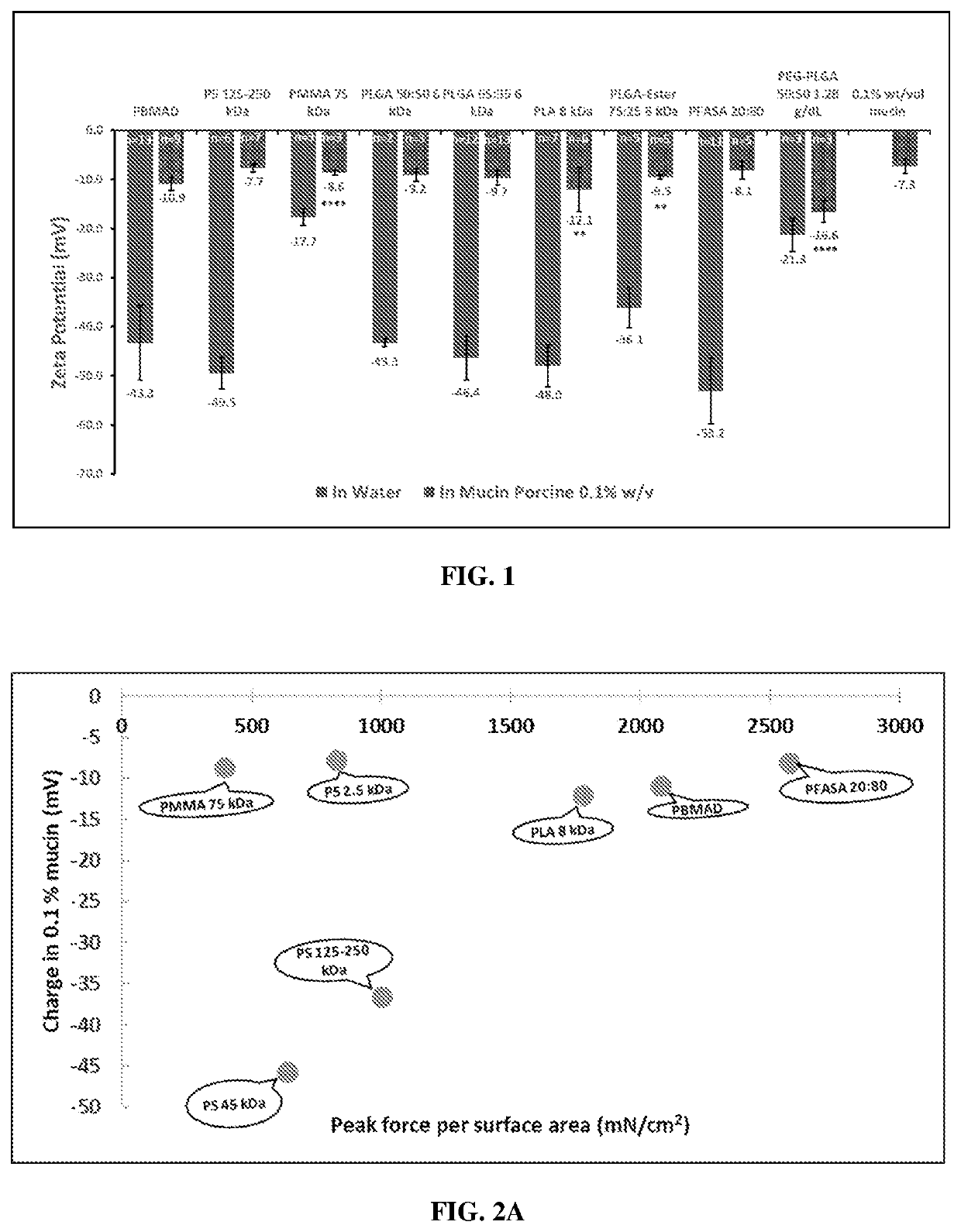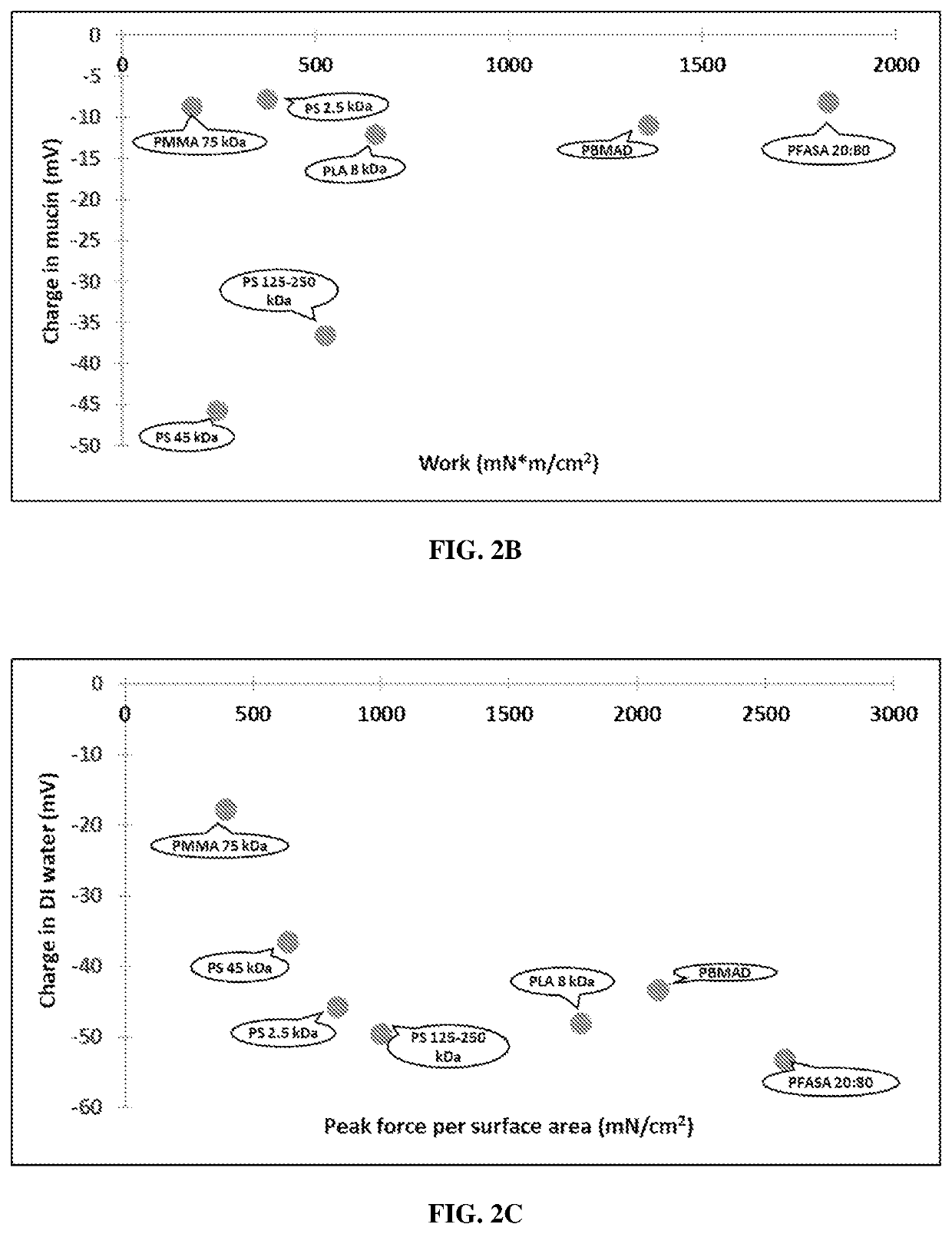Oral formulations with increased uptake
a technology of oral formulations and uptake, applied in the field of systemic delivery of therapeutic, diagnostic and/or prophylactic agents, can solve the problems of reducing the efficiency of such delivery systems, unable to investigate systemic uptake of pegylated particles, and difficult to achieve effective amounts of these agents systemically or in some cases the intestinal epithelial tissue,
- Summary
- Abstract
- Description
- Claims
- Application Information
AI Technical Summary
Benefits of technology
Problems solved by technology
Method used
Image
Examples
example 1
ts of Environment (Water and Mucin) on the Zeta Potentials (Surface Charge) of the Polymeric Particles
Materials and Methods
[0175]Materials were purchased from Fisher-scientific or Polysciences. Measurements were all made using a Malvern Zetasizer. Blank polymeric nanospheres were prepared using Phase Inversion Nanoencapsulation method (PIN), developed and patented by Mathiowitz lab (Mathiowitz, Chickering, et al.). Around 80 mg of bulk polymeric material was dissolved in 5.3 mL of dichloromethane (DCM), keeping the ratio of polymer to DCM at 1.5% w / v. DCM, served as “good” solvent for all the polymers used, apart from PBMAD (ethanol was used instead). The solution was vortexed for about 30 seconds and then sonicated for 30 seconds using Ultrasonic Homogenizer CV26 (Cole-Palmer; Vernon-Hills, Ill.) until the polymer was completely dissolved, resulting in a clear solution. Depending on the polymer used, more vortexing / sonication rounds might have been performed for complete dissolutio...
example 2
ionship Between Charge and Bioadhesion Force or Bioadhesion Work
Materials and Methods
[0178]Bioadhesion measurements were performed on the polymeric particles manufactured in Example 1. FIGS. 2A-2D contain bioadhesion data that were obtained via in vitro experiments with rat tissue. Tensile testing was done using the Texture Analyzer TA.XTplus (Stable MicroSystems, Godalming, UK) and corresponding Texture Exponent software. Standard straight pins with spherical glass heads and nickel-plated steel pin bodies were used as the probes.
Intestinal tissue was excised from adult male Sprague-Dawley rats immediately post-mortem.
[0179]Polymer Solution Preparation:
[0180]Each polymer solution of 5% weight / volume was prepared in a glass scintillation vial by adding 300 mg of polymer to 5 mL of solvent. Solvents were chosen based on known solubilities and introduced to the glass heads of the pin probes. Dichloromethane (DCM) was chosen as the solvent for polystyrene, FASA 20:80, polyaspirin, PLGA,...
example 3
Particle Size and Absorption in the GI
Materials and Methods
[0190]For in vitro experiments, an Albino, Sprague-Dawley male rat was fasted for 24 h prior to surgery. Rats were euthanized using CO2 asphyxiation and subsequent excision of the diaphragm. The anterior abdomen was shaved and an incision was made along the sternum followed by harvesting of the small intestine. Then, the intestine was divided into the duodenum, jejunum, and ileum sections (˜1:2:2 ratios respectively). To ensure proper removal of fecal matter, the sections were rinsed each with approximately 3 mL of PBS. Then each section was bisected, splayed and cut into several sections of 2 cm each. For this section procedure, the duodenum was cut into 4 cm long samples. Each of these pieces was cut into 2 cm long samples (with and without mucus). Next, the splayed tissue sections were pinned to PDMS (wetted with PBS) blocks for exposure. Then, each of the tested polymeric particles was dispersed in 200 μL of phosphate-bu...
PUM
| Property | Measurement | Unit |
|---|---|---|
| diameter | aaaaa | aaaaa |
| diameter | aaaaa | aaaaa |
| diameter | aaaaa | aaaaa |
Abstract
Description
Claims
Application Information
 Login to View More
Login to View More - R&D
- Intellectual Property
- Life Sciences
- Materials
- Tech Scout
- Unparalleled Data Quality
- Higher Quality Content
- 60% Fewer Hallucinations
Browse by: Latest US Patents, China's latest patents, Technical Efficacy Thesaurus, Application Domain, Technology Topic, Popular Technical Reports.
© 2025 PatSnap. All rights reserved.Legal|Privacy policy|Modern Slavery Act Transparency Statement|Sitemap|About US| Contact US: help@patsnap.com



